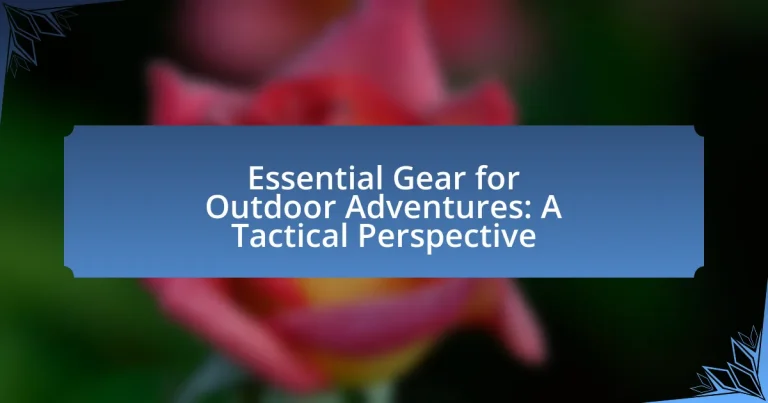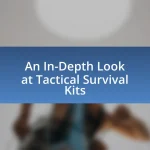Essential gear for outdoor adventures from a tactical perspective includes items such as multi-tools, tactical flashlights, durable backpacks, hydration systems, and first aid kits. These tools enhance safety, efficiency, and preparedness in outdoor environments by providing durability, functionality, and adaptability. The article explores how tactical gear differs from standard outdoor equipment, the importance of selecting appropriate gear for safety, and the risks associated with inadequate equipment. Additionally, it outlines essential components of a tactical outdoor gear checklist and best practices for using tactical gear effectively in various environments.

What is Essential Gear for Outdoor Adventures from a Tactical Perspective?
Essential gear for outdoor adventures from a tactical perspective includes a multi-tool, tactical flashlight, durable backpack, hydration system, and first aid kit. A multi-tool provides versatility for various tasks, while a tactical flashlight ensures visibility in low-light conditions. A durable backpack is crucial for carrying equipment efficiently, and a hydration system allows for easy access to water, which is vital for survival. A first aid kit is essential for addressing injuries or emergencies that may arise during outdoor activities. These items are fundamental for enhancing safety, efficiency, and preparedness in outdoor environments.
How does tactical gear enhance outdoor adventures?
Tactical gear enhances outdoor adventures by providing durability, functionality, and adaptability in various environments. This specialized equipment, such as multi-pocketed vests, weather-resistant clothing, and modular backpacks, is designed to withstand harsh conditions while offering easy access to essential tools and supplies. For instance, tactical backpacks often feature MOLLE (Modular Lightweight Load-carrying Equipment) systems that allow users to customize their loadout based on specific needs, improving efficiency during activities like hiking or camping. Additionally, tactical gear is often made from high-quality materials that resist wear and tear, ensuring longevity and reliability in outdoor settings.
What specific features make tactical gear suitable for outdoor use?
Tactical gear is suitable for outdoor use due to its durability, weather resistance, modularity, and functionality. The materials used in tactical gear, such as nylon and polyester, provide high resistance to wear and tear, making it ideal for rugged environments. Additionally, many tactical items are designed to be water-resistant or waterproof, ensuring that they can withstand rain and moisture. The modular design allows users to customize their gear with various attachments, enhancing versatility for different outdoor activities. Furthermore, features like multiple pockets, reinforced stitching, and ergonomic designs improve usability and comfort during extended outdoor excursions.
How does tactical gear differ from standard outdoor equipment?
Tactical gear differs from standard outdoor equipment primarily in its design and functionality, as tactical gear is specifically engineered for high-stakes environments, emphasizing durability, versatility, and operational efficiency. Tactical gear often includes features such as reinforced stitching, modular attachment systems like MOLLE (Modular Lightweight Load-carrying Equipment), and specialized pockets for carrying tools and weapons, which are not typically found in standard outdoor equipment. For example, tactical backpacks are designed to withstand harsh conditions and provide quick access to essential items, while standard outdoor backpacks may prioritize comfort and lightweight materials over ruggedness. This distinction is crucial for users who require reliable performance in demanding situations, such as military personnel or law enforcement officers, where the gear must support specific operational needs.
Why is selecting the right gear crucial for outdoor safety?
Selecting the right gear is crucial for outdoor safety because it directly impacts a person’s ability to respond to environmental challenges and emergencies. Proper gear, such as weather-appropriate clothing, reliable navigation tools, and adequate safety equipment, enhances protection against elements like extreme temperatures, rough terrain, and potential hazards. For instance, studies show that wearing appropriate footwear can reduce the risk of injuries by up to 50% in outdoor activities. Additionally, using gear designed for specific conditions, such as waterproof tents in rainy environments, ensures that individuals remain dry and safe, thereby preventing hypothermia or other weather-related issues.
What are the risks of inadequate gear during outdoor activities?
Inadequate gear during outdoor activities significantly increases the risk of injury and accidents. For instance, using improper footwear can lead to slips, falls, or blisters, which can hinder mobility and cause serious injuries. Additionally, insufficient clothing for weather conditions can result in hypothermia or heat exhaustion, depending on the environment. A study by the American Journal of Sports Medicine found that 30% of outdoor injuries are related to inadequate equipment, highlighting the importance of proper gear for safety. Furthermore, lacking essential tools like first aid kits or navigation devices can exacerbate emergencies, making it difficult to respond effectively in critical situations.
How can proper gear prevent accidents in the wilderness?
Proper gear can prevent accidents in the wilderness by providing essential protection, enhancing visibility, and ensuring preparedness for various environmental conditions. For instance, wearing appropriate footwear reduces the risk of slips and falls on uneven terrain, while weather-resistant clothing protects against hypothermia in cold or wet conditions. Additionally, gear such as headlamps improves visibility during low-light situations, reducing the likelihood of accidents. Statistics show that 70% of outdoor accidents are related to inadequate preparation and equipment, highlighting the importance of using proper gear to mitigate risks effectively.
What types of tactical gear are essential for outdoor adventures?
Essential tactical gear for outdoor adventures includes backpacks, multi-tools, tactical clothing, first aid kits, and navigation tools. Backpacks designed for tactical use offer durability and organization for carrying essential items. Multi-tools provide versatility for various tasks, from repairs to food preparation. Tactical clothing, often made from moisture-wicking and durable materials, enhances comfort and protection in diverse weather conditions. First aid kits are crucial for addressing injuries or emergencies that may arise during outdoor activities. Navigation tools, such as compasses and GPS devices, ensure accurate route finding and safety in unfamiliar terrains. These items collectively enhance preparedness and safety during outdoor adventures.
What are the must-have items for a tactical outdoor kit?
A tactical outdoor kit must include a multi-tool, a reliable flashlight, a first aid kit, a durable backpack, and a water purification system. These items are essential for survival and efficiency in outdoor environments. A multi-tool provides versatility for various tasks, while a reliable flashlight ensures visibility in low-light conditions. A first aid kit is crucial for addressing injuries, and a durable backpack allows for easy transport of gear. Lastly, a water purification system is vital for ensuring access to safe drinking water, which is supported by the fact that hydration is critical for survival in outdoor settings.
How do different environments influence gear selection?
Different environments significantly influence gear selection by dictating the specific requirements for safety, functionality, and comfort. For instance, in cold environments, gear must provide insulation and moisture-wicking properties to prevent hypothermia, while in hot climates, lightweight and breathable materials are essential to avoid overheating. Research indicates that outdoor enthusiasts often choose gear based on environmental factors such as temperature, terrain, and weather conditions, which directly affect performance and safety. For example, a study published in the Journal of Outdoor Recreation and Tourism highlights that hikers in mountainous regions prioritize durable footwear and weather-resistant clothing to navigate challenging terrains and unpredictable weather. Thus, the environment shapes the choice of gear to ensure optimal performance and safety during outdoor activities.
How can one effectively transition from general gear knowledge to tactical specifics?
To effectively transition from general gear knowledge to tactical specifics, one must engage in practical application and scenario-based training. This involves using the gear in real-world situations to understand its tactical advantages and limitations. For instance, participating in field exercises or simulations allows individuals to assess how different gear performs under various conditions, thereby enhancing their tactical decision-making skills. Research indicates that experiential learning significantly improves retention and application of knowledge, as seen in military training programs where hands-on experience is prioritized.
What considerations should be made when choosing tactical gear for specific activities?
When choosing tactical gear for specific activities, one must consider the intended use, environment, and required functionality. The intended use dictates the type of gear needed; for example, gear for hiking differs from that for combat or survival scenarios. The environment, including weather conditions and terrain, influences material selection and durability; waterproof materials are essential for wet conditions, while lightweight fabrics are preferable for hot climates. Required functionality encompasses features such as storage capacity, ease of access, and compatibility with other gear, which are critical for efficiency and safety during activities. These considerations ensure that the tactical gear effectively meets the demands of the specific activity, enhancing performance and safety.
What are the key components of a tactical outdoor gear checklist?
The key components of a tactical outdoor gear checklist include essential items for survival, navigation, shelter, clothing, food, water, first aid, and tools. Survival items such as a multi-tool, fire starter, and emergency blanket are crucial for unexpected situations. Navigation gear, including a map, compass, and GPS device, ensures accurate route finding. Shelter components like a tent or tarp provide protection from the elements. Appropriate clothing, including moisture-wicking layers and durable footwear, enhances comfort and safety. Food supplies should consist of non-perishable items, while water purification methods, such as filters or tablets, are vital for hydration. A first aid kit addresses medical needs, and tools like a knife or axe assist in various tasks. These components collectively ensure preparedness for outdoor adventures, aligning with tactical principles of efficiency and effectiveness.
How can one prioritize items on a tactical gear checklist?
To prioritize items on a tactical gear checklist, one should assess the mission requirements, environmental conditions, and personal needs. This involves categorizing gear into essential, important, and optional items based on their relevance to the specific outdoor adventure. For instance, essential items may include a first aid kit and navigation tools, while optional items could be additional comfort gear. Prioritization ensures that the most critical equipment is readily available, enhancing safety and effectiveness during the adventure.
What additional accessories enhance the functionality of tactical gear?
Additional accessories that enhance the functionality of tactical gear include modular pouches, hydration systems, and tactical belts. Modular pouches allow for customizable storage options, enabling users to carry essential items efficiently. Hydration systems, such as water bladders or tactical canteens, ensure that users remain hydrated during extended outdoor activities. Tactical belts provide support for carrying tools and equipment securely, improving accessibility and weight distribution. These accessories are widely recognized for their effectiveness in optimizing the performance and usability of tactical gear in various outdoor scenarios.
What best practices should be followed when using tactical gear in outdoor adventures?
When using tactical gear in outdoor adventures, it is essential to ensure proper fit and functionality. Properly fitted gear enhances mobility and comfort, reducing the risk of injury during activities. Additionally, selecting gear based on the specific environment and activity type is crucial; for example, waterproof materials are beneficial in wet conditions, while lightweight options are preferable for long hikes. Regular maintenance of tactical gear, such as cleaning and inspecting for damage, ensures reliability and longevity. Furthermore, familiarizing oneself with the gear before the adventure allows for efficient use in critical situations. These practices are supported by outdoor survival experts who emphasize the importance of preparedness and adaptability in varying conditions.


